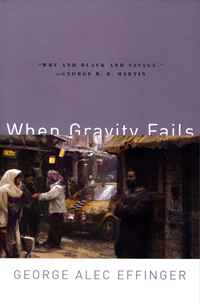When Gravity Fails was published in 1987 and its future has dated astonishingly well. Indeed, it seems much more plausible as the future of 2010 than it did when I first read it in 1988—though it doesn’t seem as if it will take as long as 2172 to get there. The Soviet Union has disintegrated at some point in the past into numerous splinter successor states. The United States has done the same, and so has the European Union, mostly splintering down beyond the country level—but Germany has reunited. The Islamic world looks on with hungry eyes. Meanwhile, everyone has a mobile phone, direct neural interfacing using modular personalities (“moddys”) and add-ons (“daddies”) is common, and gender reassignment (male to female or female to male) is optional, effective, and easy, but expensive. Marid Audran, son of a Fellahin mother and a French father, is just trying to make a living as a private investigator in an unnamed North African city somewhere east of Algiers, when his life gets complicated by a series of murders. It has barely dated at all.
I originally picked it up back in 1988 because the notion of a noir detective in an Islamic future intrigued me, and I bought it because the first paragraph just totally hooked me.
Chiriga’s nightclub was right in the middle of the Budayeen, eight blocks from the eastern gate, eight blocks from the cemetery. It was handy to have the graveyard so close-at-hand. The Budayeen was a dangerous place and everyone knew it. That’s why there was a wall around three sides. Travelers were warned away from the Budayeen, but they came anyway. They’d heard about it all their lives and they were damned if they were going home without seeing it for themselves. Most of them came in the Eastern gate and started up the Street curiously; they’d begin to get a little edgy after two or three blocks, and they’d find a place to sit and have a drink or eat a pill or two. After that they’d hurry back the way they’d come, and count themselves lucky to get back to the hotel. A few weren’t so lucky and stayed behind in the cemetery. Like I said, it was a very conveniently located cemetery and saved trouble all around.
Effinger’s writing on the word and sentence level is just beautiful, the voice is perfect, and remains so all the way through, and the way he wraps the theme around there is what he does in the whole book.
This was a book that couldn’t have happened without cyberpunk, but which itself isn’t cyberpunk. There are no hackers here, and almost no computers—though it feels reasonable for the Budayeen that there wouldn’t be. Holoporn, yes, drugs to get you up or down, prostitutes of all genders and some in between, personality modules of anything from salesmen to serial killers via sex kittens, but no computers. The street is what comes from cyberpunk, and perhaps the neural wiring, a little. But what Effinger does with it, making it a North African street that really feels like something out of the future of another culture, is entirely his own. Effinger said the Budayeen was based on the French Quarter of New Orleans, where he lived, as much as it was based on anywhere, but it has the feel of a real place, grimy and edgy and run down and full of the wrong sort of bars.
The detective story is just the plot that keeps everything moving. The real story is about Marid Audran’s orbit through the Budayeen and himself. He solves the mystery, both mysteries, but that’s not the most important thing. The book’s title, which sounds so solidly science fictional, is from Dylan “when gravity fails and negativity won’t pull you through”. This is the story of what happens to you when that happens to you. Effinger could really write and he doesn’t pull his punches—this can be disturbing, and it’s all first person and very close at hand. It’s also very clever and darkly funny.
There are two sequels, A Fire in the Sun and The Exile Kiss. They’re just as brilliantly written, but I seldom re-read them. There are two reasons for that. The first is that When Gravity Fails stands alone pretty well, there’s room for more, certainly, but it finishes a trajectory. The three books taken together set up a new trajectory that aches for a fourth volume, which will never be completed due to the US’s lack of a decent healthcare system and Effinger’s early death in 2002. The other reason is that the second and third book get very bleak, and I don’t always have the fortitude for that.
Jo Walton is a science fiction and fantasy writer. She’s published eight novels, most recently Half a Crown and Lifelode, and two poetry collections. She reads a lot, and blogs about it here regularly. She comes from Wales but lives in Montreal where the food and books are more varied.










